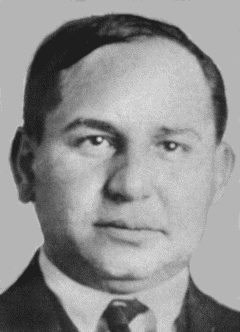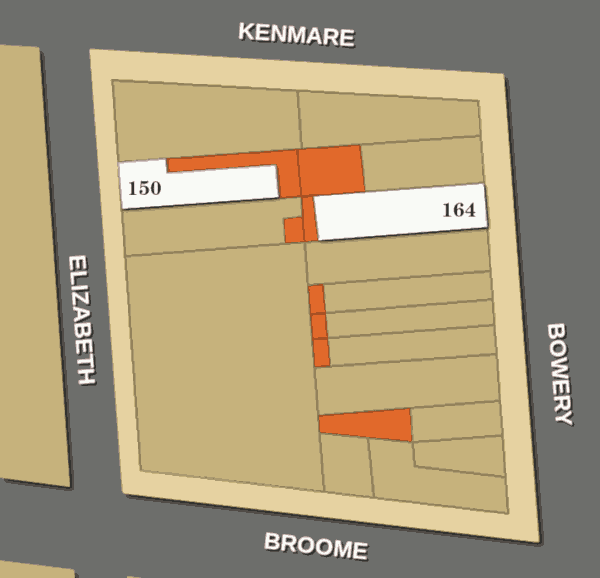

This article was originally written in February 2020. It was revised and reformatted in March 2022.

Masseria
[Editor's note: With this short article, we have provided source documents - prosecutor files and copyright-expired newspaper clippings - and some document transcriptions in order that the reader may discover details of this early event in the underworld career of "Joe the Boss" Masseria. Some of the documents may be difficult to read, as we were forced to sacrifice some clarity to achieve manageable file sizes.]
Sunday morning, April 13, 1913, police of New York's Twelfth Precinct were alerted to an attempted robbery at a Lower East Side pawnshop. Officers arriving at Simpson's Pawnshop, 164 Bowery near the intersection with Kenmare Street, found the front of the building securely locked.
They were initially unable to access the rear of the building, as it bordered a courtyard surrounded by structures. The police found that they could best see through the courtyard from the rear of an apartment house on Elizabeth Street. When they did so, they discovered that a hole had been cut through the back wall of the Simpson's building. A makeshift ladder and scaffolding were observed in that area.
Figuring that those who cut the hole probably got into the yard through the same apartment house and might yet be hiding within it, police Captain William Kinsler stationed an officer at the front of the building, 150 Elizabeth Street, with orders not to allow anyone to leave.
At about eight o'clock that morning, Officer James Reilly stopped twenty-seven-year-old Giuseppe Masseria as he stepped out the front door of the house. Masseria casually deposited a bag in a garbage pail, as Reilly began to question him. Masseria told the officer he was visiting a friend on the first floor of the house and did the favor of throwing out some old bread. (It is uncertain if the officer made any effort to verify that the discarded item contained bread and only bread.) He said he lived about half a mile away at 217 Forsythe Street, near East Houston Street, where he ran a saloon.

The rear of Simpson's Pawnshop at 164 Bowery was accessed through a yard (shown in orange) behind the apartment building at 150 Elizabeth Street. The structure directly behind Simpson's was home to a factory. An entrance for subway trains bound for Brooklyn sat at about the middle of this block on Kenmare street. (Info source: 1916 Borough of Manhattan Atlas, New York Public Library)
Moments later, Giuseppe and Salvatore Ruffino, brothers, emerged from the building. Reilly stopped them and questioned them. They said they were residents of North Fifth Street and North Sixth Street, near Roebling Street, in Brooklyn and were visiting a friend. (That area of Brooklyn has since become known as the base of operations of Castellammarese Mafiosi and the later Bonanno Crime Family.)
Masseria and the Ruffinos were arrested as suspects in the pawnshop break-in. They were taken to the police station, 205 Mulberry Street, for processing.
Police then explored the apartment house and found Pietro Lagattuta (his surname was spelled Lagatutta in official documents) in a first-floor rear apartment. Lagattuta said he recently rented the two-bedroom apartment for himself, but he acknowledged that his primary residence was 96 East Houston Street. In a search of the rooms, police found a handgun, a bit of lumber, some wet clothing covered with brick dust and mortar.
Lagattuta also was arrested and taken to the station.
Representatives of an alarm company went to Simpson's Pawnshop to let the police inside. Their investigation showed that intruders had accessed the shop through the hole in the wall and had approached the business vault before something scared them off.
Masseria, Lagattuta and the Ruffinos were placed in the station house lockup. Police officers who understood Italian were secretly stationed nearby and heard the four men conspiring on cover stories.
In this section, clicking on either the article icon or its title will open an image of the newspaper article.
Further investigation at 150 Elizabeth Street uncovered a large and expensive set of tools hidden in the cellar.
The tools included electric drills, chisels, pickaxe, heavy hammer, pipe cutter and torch cutter. Fingerprinting was used to match the tools to Masseria and Lagattuta. (The absence of Ruffino fingerprints may have caused prosecutors to pursue a separate case against Masseria and Lagattuta.)
In the same area was found some boards that matched those used in the ladder and scaffolding.
In this section, clicking on either the article icon or its title will open an image of the newspaper article.
Police records showed that Masseria had previously been arrested for burglary and extortion.
Police told the press that they believed the four men arrested could have been responsible for a dozen unsolved Lower East Side burglaries over the previous fourteen months.
The four suspects were indicted April 21 for third degree burglary in connection with the pawnshop break-in. They were not charged with the other burglary cases police had hoped to close.
In this section, clicking on the document icon will open an image of the document, while clicking on the document title will open a transcription. These items were obtained through the New York City Municipal Archives.
Masseria and Lagattuta went to trial before General Sessions Court Judge Crain in May. Press reports indicated that the Ruffino brothers - released on bail - would be brought to trial soon, but no further mention of the Ruffinos could be found in the newspapers.
In this section, clicking on the document icon will open an image of the document, while clicking on the document title will open a transcription. These items were obtained through the New York City Municipal Archives.
Masseria and Lagattuta were convicted of burglary. Sentencing occurred on May 23. Lagattuta was sentenced to serve between two and a half and five years in prison. Because Masseria had a previous criminal record, he was sentenced to four to six years in prison.
In this section, clicking on either the article icon or its title will open an image of the newspaper article.
Note: In this section, clicking on either the document icon or its title will open an image of the document.